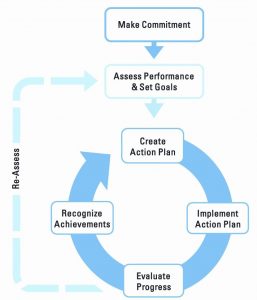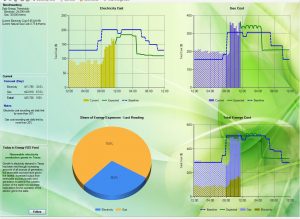Any organization—small business, local township, international corporation, large state—reaps benefits from planning for energy efficiency. Thinking strategically about energy use can help your organization reduce bottom line costs, minimize impacts, maximize achievements, and take advantage of available resources. According to the U. S. Environmental Protection Agency (EPA) National Action Plan for Energy Efficiency (2007):
Improving energy efficiency in our homes, businesses, schools, governments, and industries—which collectively consume more than 70 percent of the natural gas and electricity used in the country—is one of the most constructive, cost-effective ways to address the challenges of high energy prices, energy security and independence, air pollution, and global climate change.
The many benefits of energy efficiency include:
- Environmental: Can result in decreased greenhouse gas emissions and water usage, as well as reduced amounts of other pollutants.
- Economic: Less costly than investments for additional generation and transmission capabilities; spending on energy efficiency investments can support the local economy.
- Utility System Benefits: Improved energy efficiency can decrease baseload and peak demand, thereby reducing the necessity for further generation and transmission capital investments.
- Risk Management: Can provide a hedge against the uncertainties related to rising fuel costs as well as other risk factors. Energy efficiency may also result in diversification in utility portfolios (2)
SEDAC provides a host of resources that can assist organizations with planning for energy efficiency and enhanced beneficial outcomes.
A planning process for improving building energy efficiency is a critical tool. While acknowledging the crucial need to plan for energy efficiency in transportation, industrial processes, and other areas, this document focuses on buildings and for the communities and organizations that own, operate and/or influence a portfolio of buildings. The ENERGY STAR® seven step Guidelines for Energy Management is used to outline an approach for plan implementation. (3)
Roadmap for energy management
A planning process for continuous improvement toward energy performance goals has been developed by the EPA ENERGY STAR program. The process builds on the commitment organizations make when they become an ENERGY STAR partner. This energy management roadmap can help your organization improve its financial performance while distinguishing it as an environmental leader. Thousands of organizations have used these Guidelines to formulate an energy management approach that delivers results and demonstrates leadership.
 Step 1. Make a commitment
Step 1. Make a commitment
Effective planning for energy efficiency requires a commitment from your community or organization. This commitment is often expressed in a formal policy. Policies can take many forms and describe varying levels of detail. Many effective policies are brief, high-level documents that acknowledge the importance of energy efficiency, indicate the key factors that motivate the commitment, empower people to take action on the policy, and specify the general scope of action.
An energy policy creates the foundation for setting goals and making plans. Cost savings and atmospheric emission reductions are key factors that typically motivate commitment. You may want to conduct public meetings to assess interest, build support for energy efficiency efforts, and solicit support from stakeholders. One way to engage community members is to establish a Community Advisory Board to guide the planning process.
Energy management will require ongoing attention. Create a team that will take responsibility, help marshal ideas, and gauge progress. Include decision-makers, maintenance personnel, and finance experts, in addition to others interested in energy efficiency. The team will invest time in the planning phase, but will also need to be available as energy efficiency measures are implemented and savings are monitored. Your team should encompass your entire planning sphere.
Questions to resolve include: What is the scope of your planning effort? Are you seeking to address energy efficiency within your organization or do you want to extend your efforts to the community as a whole? Consider how energy efficiency planning fits into the organization’s ongoing work. Can energy efficiency planning be integrated with existing initiatives such as a Climate Action Plan, Capital Improvements Plan, or building codes and enforcement?
Step 2. Assess performance
Before investing in energy efficiency efforts, establish an energy use baseline so you can: a) assess how you currently use energy, and b) determine how your efforts will impact energy use, finances, and other relevant organization or community issues (carbon emissions for example). Benchmarking is a good way to compare a building or organization’s energy performance with similar entities. Energy assessments for individual buildings can help you understand the energy use patterns and opportunities for improvement within a particular building. See the Benchmarking and Energy Assessment Resources link for a compendium of technical support entities.
Step 3. Set goals
To obtain measurable results, your team should establish clear goals. Set goals at the organizational level, but also by facility, process, and equipment. If the plan involves the community, establish some goals at a broader level. Be sure to engage affected stakeholders in goal setting to increase their buy-in during implementation. Be specific. Express the goals you want to achieve using measurable indicators and time frames. In this way, you will be able to measure your improvements and understand whether you achieved the expected results. Is there room for further improvement? Were your results different from what you expected? The goals, both for the short and the long term, must be realistic. At the same time, do not be afraid to offer challenges for your team, your community, and yourself.
Step 4. Create an action plan
Depending on scope, your action plan may be a simple prioritized list or an in-depth document with multiple chapters. Using results of the energy assessment and benchmarking process, outline steps you will take to reach goals. Set timelines for actions and prioritize your energy efficiency projects. Energy use intensity and energy costs are two metrics that can help you rank the urgency of improvements to buildings in your portfolio.
An action plan is not static, but rather a ‘living’ document. The plan should be revisited and updated regularly. Add information related to improvements and shortcomings when known; adjust goals and/or timelines as needed. Consider monitoring ongoing progress, rather than evaluating at the end of each phase. Assign roles and resources to each action. Do the members of your team have the authority or resources to carry out actions? Who else will be involved in project implementation?
When assigning priorities, assess funding and resources. How will you fund your capital expenditures? Are funds available in the current budget? Will you have to issue bonds or take out a loan? What are immediate opportunities for energy and cost savings that can be easily implemented? Which projects will be end-of-life equipment replacements?
Consider using savings from earlier efforts to pay for future, more complex initiatives. An Energy Performance Contract (EPC) provides a means for an organization to finance energy efficiency projects over time, using the energy cost savings over a set period. Consider whether you will apply for available incentive funding. Most incentive programs require a pre-approval application to be sure that the selected equipment meets program specifications. For residential or private sector projects, tax credits may also be available after projects are complete. See the Funding for Energy Efficiency Resources link for more information.
Step 5. Implement the plan
As you begin to implement your energy efficiency action plan, you will need to communicate inside and outside your organization. You may need to explain why you are pursuing certain projects or making (or not making) specific changes. Celebrating your success can help engage the organization, generate momentum for other projects, and/or boost your organization’s reputation. See the link on Communications Strategies for Energy Efficiency to learn more.
Set the example for your team and your community! Changing your behavior can be a powerful tool to motivate your team or community to do the same. Show your team how they can reduce consumption and provide them with the tools and training to do so. Motivational messages or raising awareness may not be enough. Think about creating a system of incentives for your employees or the community.
Creating partnerships with external entities, organizations, and civil society groups could be a key to success in reducing energy consumption in your community and a way to involve its members. A more sustainable and inclusive approach can help you to achieve your goals and encourage people to care about energy efficiency initiatives. Work with staff or contractors to complete energy efficiency projects. SEDAC maintains links to utility and state energy service provider directories. You may need to offer training to equipment operators, occupants of your premises and your community on how to operate new equipment or opportunities for behavior change. Consider sending building operators to Building Operator Certification Training.
Step 6. Evaluate progress
Evaluate your progress while the process is ongoing. Compare your performance with the goals you set in your action plan. Look at these goals vis–à–vis the data you collect about your energy usage to ascertain goal achievement. (See Figure 2 for one example.) Identify successful areas of intervention, best practices, and areas where you need to change your approach. Adjust procedures and goals accordingly. Determine when your next evaluation will take place.
Step 7. Recognize achievements
Underline the successes your team achieved—as well as the challenges encountered—in their efforts to improve energy efficiency. These observances of success can motivate further improvements, and as well, show a positive image of your organization to others. To provide internal recognition, establish the criteria on which you will base your evaluation and who should be recognized for the best achievements. Who had the most original idea? Who motivated others most? You can decide to give a symbolic gift or to organize an event for the occasion.
At the same time, seek recognition from external sources. The efforts made by your team should be publicized and be visible for others as well. See the link on Sources of Recognition.

Conclusion
The ENERGY STAR Guidelines for Energy management are useful for any organization thinking strategically about energy efficiency. Many other local, state, and national resources are available to help organizations plan and implement energy savings measures. Check out the following resources:






